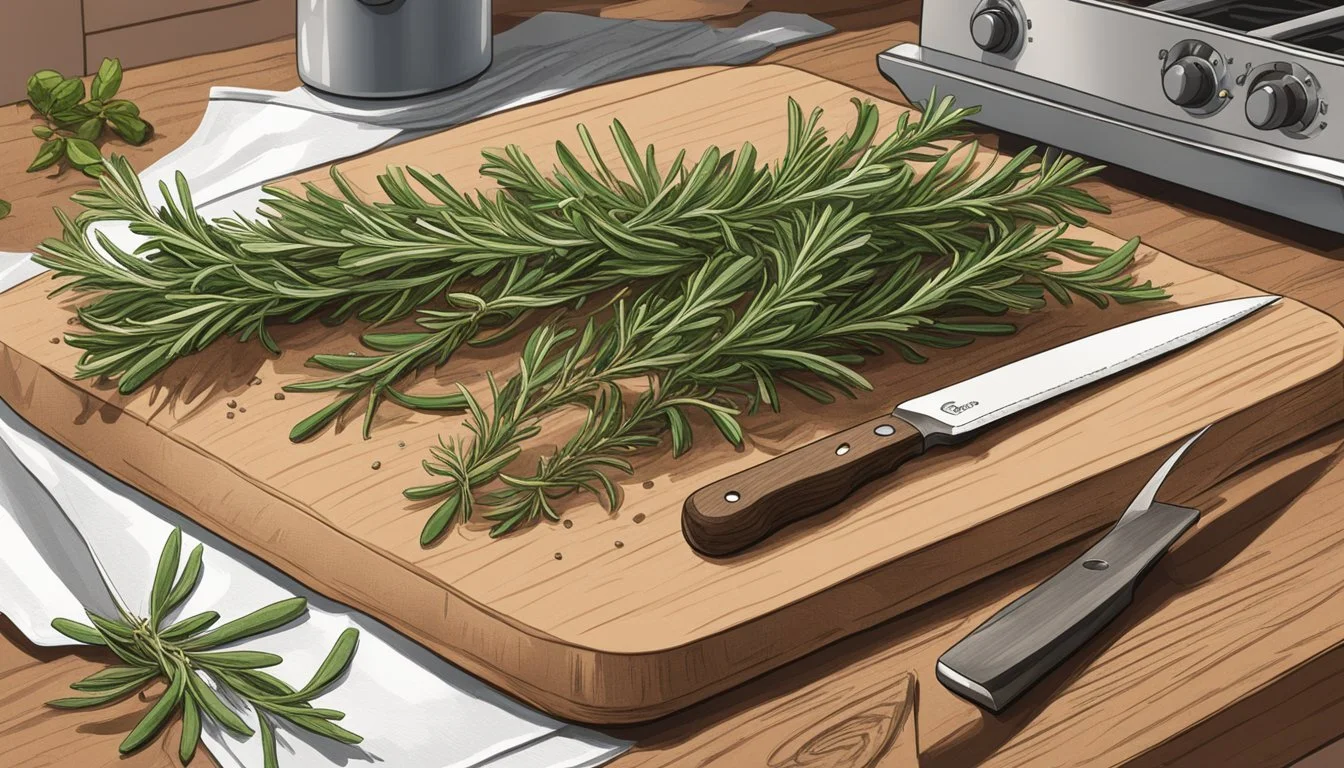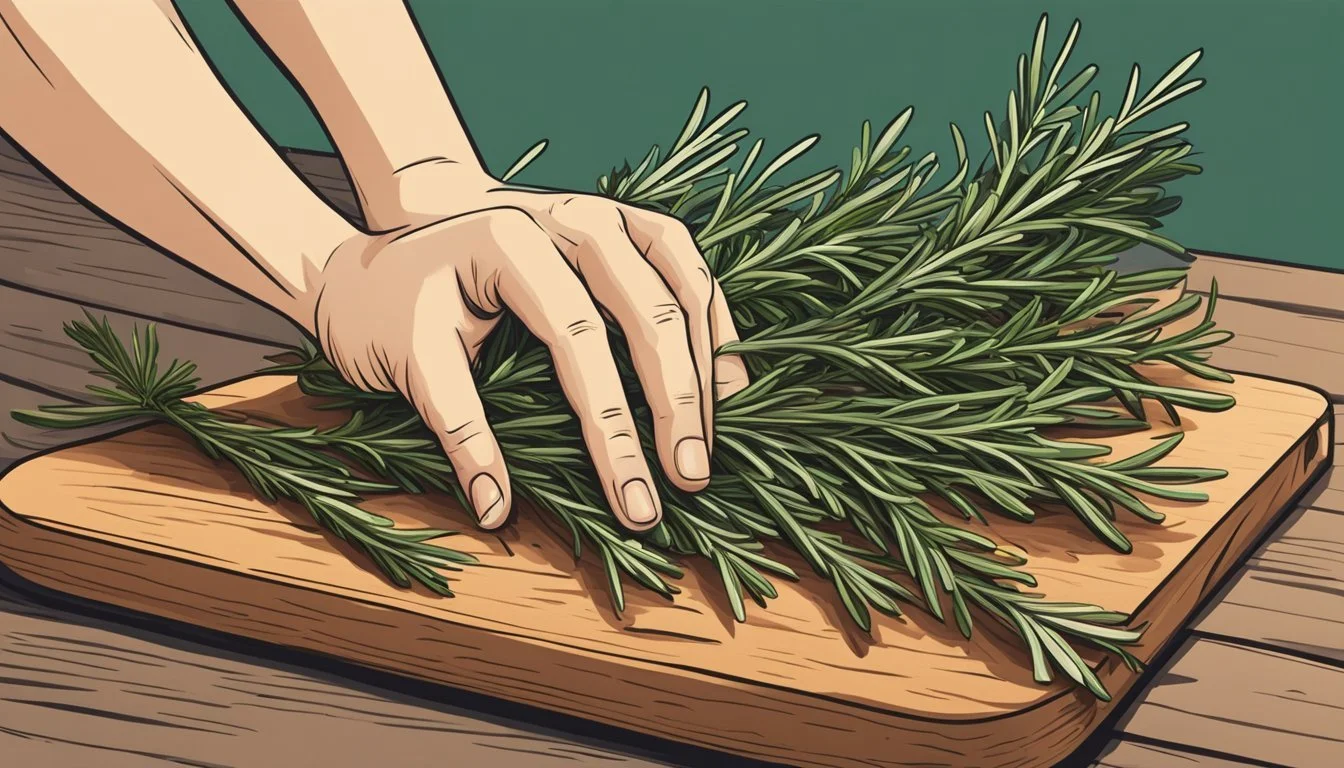How Long Does Rosemary Last?
Shelf Life and Preservation Tips
Fresh rosemary, with its vibrant aroma and flavor, is a staple in kitchens worldwide. Understanding how to extend the shelf life of this herb is essential for both home cooks and professional chefs. The longevity of rosemary is influenced by various storage methods, each offering different durations of freshness. When stored in the fridge, rosemary can remain fresh for 10 to 14 days when placed in bags, and up to four weeks if kept in a jar of water. For those who prefer keeping their herbs within arm's reach, placing rosemary in a jar of water at room temperature on the counter can preserve it for 2 to 3 weeks.
Alternatively, the freezer presents a viable option for long-term storage, extending rosemary's usability to 4 to 6 months. To maximize preservation, it is crucial to thoroughly dry the sprigs of rosemary and chop them into smaller pieces before placing them in freezer-safe bags. Proper storage not only maintains the herb's quality but also reduces food waste, ensuring that the rosemary's distinctive piney flavor is available whenever it's needed to enhance a dish.
Rosemary Overview
Rosemary is a perennial herb known for its aromatic and flavorful qualities, making it a staple in culinary uses. It contributes significantly to recipes and holds a profile that enhances dishes, especially those involving chicken and lamb.
Types of Rosemary
Rosemary comes in various types, each with distinct characteristics. Some common varieties include:
Upright Rosemary (Rosmarinus officinalis): Typically used for culinary purposes, exhibiting a robust flavor.
Prostrate Rosemary (Rosmarinus officinalis 'Prostratus'): Often utilized as a ground cover due to its trailing habit and is also edible.
Culinary Uses and Flavor Profile
Rosemary is extensively used in cooking, offering a unique combination of flavors: it's aromatic, piney, and slightly bitter. Its versatility allows it to be used in:
Fresh Form: Imparting a stronger taste, ideal for seasoning meats like chicken and lamb.
Dried Form: More subtle, used in spice blends and as a seasoning.
The herb is also known for its health benefits; it can be consumed as tea to aid digestion. Rosemary's flavor compounds withstand high temperatures, making it perfect for baking and roasting recipes.
Fresh Rosemary Storage
Proper storage of fresh rosemary extends its useful life while maintaining its vibrant flavor. Two common methods involve keeping it in the refrigerator or at room temperature, each with specific steps to ensure optimal freshness.
In the Refrigerator
Storing fresh rosemary in the refrigerator is the most effective way to prolong its freshness. The recommended approach is as follows:
Wash: Gently wash the rosemary sprigs to remove any dirt or residue.
Dry: Pat them dry with paper towels or use a salad spinner to remove excess moisture, as it promotes sliminess.
Wrap: Lay the sprigs on a slightly damp paper towel to maintain moisture balance.
Bag or Airtight Container: Either:
Seal the wrapped sprigs in a zip-top bag, ensuring to expel any air before sealing.
Place the sprigs in a jar or airtight container, leaving some space for air circulation.
Fridge Placement: Store the sealed bag or container in the crisper drawer of the refrigerator to keep it away from excessive moisture or ethylene-producing fruits and vegetables.
Using this method, rosemary can stay fresh for up to two weeks, depending on the initial quality of the herbs and exact storage conditions.
At Room Temperature
For short-term storage, keeping rosemary at room temperature can be sufficient:
Preparation: Ensure the rosemary sprigs are clean and completely dry.
Parchment or Paper Towel: Wrap the rosemary loosely in a paper towel or parchment paper to absorb any moisture.
Container: Place the wrapped rosemary in an open or perforated bag that allows for air circulation.
Location: Store the bag in a cool, dry place away from direct sunlight and heat sources.
When stored at room temperature, rosemary tends to wilt more quickly, generally lasting a few days before it begins to lose its freshness.
Dried Rosemary Storage
The longevity of dried rosemary largely depends on the storage conditions. To maintain its quality for up to three years, it should be kept in a cool, dark place, away from direct sunlight and heat.
Pantry Storage
In a pantry, the best way to preserve dried rosemary is by ensuring it's stored in a well-ventilated area at a consistent, cool temperature. Key considerations include:
Coolness: A pantry should be cool to prevent the rosemary from becoming brittle and losing essential oils.
Darkness: Exposure to light can degrade the quality of the herb.
Dryness: The area should be dry to prevent moisture from seeping into the rosemary.
Glass Jar vs Plastic Bag
When deciding between glass jars and plastic bags for storage, one must consider factors like air exposure, light penetration, and moisture protection.
Glass Jar:
Advantages:
Airtight Seal: A glass jar with a tight-fitting lid helps prevent the entrance of moisture and keeps the herb dry.
Light Protection: Colored glass jars offer some protection from light, though storing in a dark place is still recommended.
Disadvantages:
Fragility: Glass is breakable and may not be as portable as plastic.
Plastic Bag:
Advantages:
Lightweight: Easier to handle and store in bulk.
Disadvantages:
Air Circulation: Plastic bags may trap air which could potentially degrade the rosemary faster.
Moisture Control: Plastic doesn't absorb moisture, which might lead to condensation if the storage area isn’t completely dry.
Maintaining the right balance of these factors in storage ensures the dried rosemary retains its flavor and aroma.
Freezing Rosemary
Freezing is an effective way to preserve the flavor and longevity of rosemary. When prepared correctly, frozen rosemary can be a convenient staple for culinary use anytime.
Using Freezer Bags
One can freeze rosemary by first ensuring the sprigs are clean and completely dry. After laying them out on a baking sheet to flash freeze, one should transfer the frozen sprigs to a freezer bag. By doing this, the individual sprigs will freeze separately, preventing clumping and making it easier to use the exact amount required for cooking, without having to thaw the entire batch.
Procedure:
Wash and thoroughly dry the rosemary.
Space out the sprigs on a tray and flash freeze for 2-3 hours.
Once frozen, quickly transfer the rosemary sprigs to a freezer bag.
Remove as much air as possible before sealing.
Label the bag with the date before placing it back in the freezer.
Oil Preservation Method
Preserving rosemary in oil not only freezes the herb effectively but also infuses the oil with its flavor. One should chop the clean, dry rosemary and mix it into olive oil before partitioning it into an ice cube tray to freeze. Once the rosemary and oil cubes are solid, they can be stored in a freezer bag for future use.
Steps:
Finely chop the dried rosemary.
Combine with olive oil in a bowl.
Pour the mixture into an ice cube tray.
Freeze until solid.
Transfer the cubes to a freezer bag and seal securely.
Each method serves to extend the shelf life of rosemary, making it easily accessible and retaining its pungent flavor for months.
Maximizing Rosemary Shelf Life
To ensure rosemary maintains its flavor and usability, proper drying and storage techniques are essential elements in maximizing its shelf life. These methods can greatly prolong the herb's freshness when applied appropriately.
Proper Drying Techniques
Air-Drying: Gather rosemary stems into small bunches, and tie them securely. Hang them upside down in a warm, dry place away from direct sunlight. Ample air circulation is crucial, as it prevents mold from developing. This process can take several days, after which the leaves should be completely dry and easily crumble between fingers.
Oven-Drying: For a quicker method, one can use an oven. Preheat it to the lowest temperature setting, usually around 180-200 degrees Fahrenheit. Arrange the rosemary sprigs on a lined baking sheet in a single layer to ensure even drying. Place them in the oven, keeping the door slightly ajar to allow moisture to escape. Monitor and turn the sprigs occasionally, drying for approximately 2-4 hours, or until completely desiccated.
Avoiding Common Storage Mistakes
Humidity and Temperature: Store dried rosemary in an airtight container in a cool, dark place to preserve its essential oils and prevent spoilage. High humidity and temperature fluctuations can degrade the herb's quality swiftly.
Light Exposure: Keep the herb away from intense light sources. Light can cause the rosemary to fade and lose its potent flavors over time.
Wet Conditions: Ensure that the rosemary is completely dry before storing it. Any residual moisture can lead to mold and a rapid decline in the herb's condition.
By vigilantly overseeing these aspects of drying and storage, one can effectively extend the shelf life of rosemary, keeping it aromatic and flavorful for future culinary use.
Identifying Spoiled Rosemary
There are definitive signs when rosemary has lost its culinary value due to spoilage, such as changes in appearance and scent.
Visual Indicators
When assessing the freshness of rosemary, its color is a primary visual cue. Healthy, fresh rosemary is characterized by vibrant green hues. If the herb displays brown or yellow spots or has become overall dull in color, these are indicators that it is on the decline. Additionally, one should look for signs of mold; white or grey fuzzy spots suggest that the rosemary is no longer suitable for consumption. The texture of the leaves can also be telling. Fresh leaves should be firm and spring back when touched. If they're wilted or brittle, the rosemary is past its prime.
Olfactory Signals
Rosemary is known for its intense and fragrant aroma, akin to pine. If there's a noticeable lack of scent or if the herb emits a musty or unpleasant smell, this indicates spoilage. The aroma of rosemary should be fresh and invigorating; an absence of this characteristic smell or the presence of any off-putting odors means that the rosemary might have gone bad. It's important to trust one's sense of smell in discerning the usability of the herb.
Rosemary Care and Harvesting
Proper care and regular harvesting are essential to maintain the vigor of rosemary plants, ensuring a steady supply of fresh herbs. Mastering the timing and techniques for pruning and watering can greatly extend the life and productivity of these aromatic plants.
Pruning and Cutting
Rosemary requires frequent pruning to encourage growth and prevent it from becoming woody. Plants should be trimmed regularly, cutting back up to one-third of the growth at a time. This not only shapes the plant but also provides material for harvest. For best results, one should:
Prune in spring to promote bushier growth.
Make cuts just above a leaf joint to encourage new stems.
Use sharp, clean shears to avoid damaging the plant.
Harvesting can be done as needed by snipping off the desired amount. Cut stems can be used fresh, or they can be dried for later use. When harvesting:
Cut stems that are at least 8 inches long, which ensures a sustainable practice.
Leave at least 5 inches of the plant base untouched to allow for regrowth.
Watering and Soil
Rosemary thrives in well-drained soil and does not tolerate overwatering. It's important to establish a proper watering schedule that keeps the soil moist but not waterlogged. Soil conditions and watering should adhere to the following guidelines:
Use well-drained soil with a pH between 6.0 and 7.0.
Water the plants deeply but infrequently, allowing the soil to dry between waterings.
Ensure pots have drainage holes to prevent root rot.
Proper care and storage methods allow one to maximize the lifespan of harvested rosemary, which, when stored properly, can last several weeks in the refrigerator or up to a year when dried and stored in an airtight container. By respecting the rosemary's growth habits and responding to its needs, gardeners can enjoy this aromatic herb throughout the year.
Additional Uses of Rosemary
Beyond its culinary applications, rosemary serves a variety of purposes in home remedies and aromatic decorations. Its health benefits and fragrant aroma make it a versatile herb for many uses.
Rosemary in Home Remedies
Rosemary has long been cherished in folk medicine due to its potential health benefits. Some people use it in homemade teas to promote digestion and alleviate symptoms of the common cold. Since rosemary is believed to have anti-inflammatory properties, it can be applied in a topical form—such as an infused oil—for relief from muscle pain and arthritis. Additionally, the aroma of rosemary is said to enhance memory and concentration, making rosemary oil a popular choice in aromatherapy practices.
Aromatic and Decorative Purposes
The strong, pleasant fragrance of rosemary makes it ideal for various aromatic and decorative uses. Bundles of dried rosemary sprigs can be hung in the home as a natural air freshener or included in potpourri mixes. Crafting wreaths from rosemary not only adds a rustic charm to home decor but also infuses rooms with its distinctive scent. Moreover, one can use a dehydrator to dry rosemary efficiently at home, preserving its aroma for an extended period and enabling its use in recipes, sachets, and other creative endeavors.
Buying and Preparing Fresh Rosemary
When selecting fresh rosemary, it is essential to look for vibrant, green leaves and to store them properly before washing to maintain their shelf life.
Selection at the Market
Shoppers should seek out sprigs of fresh rosemary that possess a rich green hue, indicative of freshness and vitality. Leaves should be free from dark spots or yellowing, which can signal age or damage. The aroma should be distinctly fragrant when lightly brushed. A tactile examination is advisable: leaves should feel springy, not limp.
Pre-Wash Storage
Before washing the rosemary, preparing it for interim storage in the kitchen is key. One should avoid washing the herb directly after purchase if it is not to be used immediately. Excess moisture can hasten decay, so the rosemary should be stored in a dry state. To do this, wrap the rosemary loosely in a dry paper towel and place it inside an airtight container or a resealable plastic bag. This method helps to absorb any extra moisture, maintaining the herb's freshness until ready for use.
Rosemary in Different Cuisines
Rosemary is a versatile herb that is pivotal in various cuisines, particularly within Mediterranean recipes and as a global seasoning method. Its ability to complement different ingredients makes it a favorite in both fresh and dried forms.
Mediterranean Recipes
In Mediterranean cooking, rosemary's piney and peppery flavor is often used to season a multitude of dishes. It is integral in recipes such as:
Soups: A staple in Mediterranean cuisine, rosemary adds depth to the flavor of soups, often complementing ingredients like tomatoes and beans.
Lamb: Rosemary pairs exceptionally well with lamb due to its strong flavor, which can stand up to the robust taste of the meat. It's commonly incorporated in marinades or as a seasoning before roasting.
This herb is also linked to the characteristic flavors found in Italian, Greek, and French cuisines. Its high iron content makes it not only a flavorful addition but also a healthful one.
Worldwide Seasoning Methods
Globally, rosemary is used to season a variety of dishes.
Dried Herbs: As a dried herb, rosemary retains its flavor and can be used in spice blends and seasonings across diverse culinary traditions.
Cooking Techniques: Whether used to infuse oils, create aromatic roasts, or to flavor bread, chefs worldwide utilize rosemary for its robust scent and taste.
The herb's adaptability means that it can be used in its fresh form for immediate cooking or dried to be stored and used over time, allowing it to grace kitchens and recipes across the globe.








